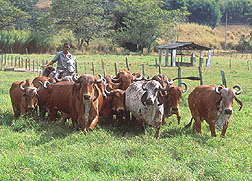This page has been archived and is being provided for reference purposes only. The page is no longer being updated, and therefore, links on the page may be invalid.
|
Read the magazine story to find out more. |
|
|
U.S.-Brazil Research Partnership Paying Off for Both Countries
By Kim KaplanDecember 4, 2001
Labex , a successful, growing collaboration between the Agricultural Research Service and a partner from Brazil, promises a range of agricultural benefits for both countries.
The Labex program, proposed by ARS’s Brazilian counterpart Empresa Brasileira de Pesquisa Agropecuaria (EMBRAPA), is proving to be a fruitful collaboration. Labex is a Portuguese term for “Virtual Lab,” so named because the program is a laboratory that exists only as a concept, without any lab buildings of its own.
Central to the program is bringing Brazilian scientists to ARS laboratories for two- to three-year terms and pairing them with appropriate ARS partners. Unlike many cooperative programs that focus on post-doctoral training, the Brazilian researchers in this program are all senior scientists. Labex also encourages other formal and informal exchanges between scientists of the two research services.
Active only since 1998, the program is already paying off in research results in integrated pest management, precision agriculture, soil science and genetic research. For example, Labex is facilitating cooperative work to find genetic resistance to internal parasites in cattle, which would be welcome in both countries. Internal parasites cost the beef and dairy industries $2 billion annually in the United States alone.
Another collaborating team is developing better biocontrols for the stink bug, a major pest of soybeans in both Brazil and the United States. The team has already identified a more complete pheromone blend to attract neotropical brown stink bugs, making it possible to monitor fields for the pests’ appearance so pesticide use can be narrowly targeted. They have also developed an effective trap design to go with the pheromone lure, for which they are currently seeking commercial producers.
Brazil proposed the Labex program because the country saw itself and the United States as natural partners in agricultural research, with many similar agricultural and environmental problems to solve. Both are also world leaders in agricultural research and technology.
To learn more about this research, see a more detailed story in the December issue of Agricultural Research magazine.
ARS is the U.S. Department of Agriculture's chief scientific research agency.

